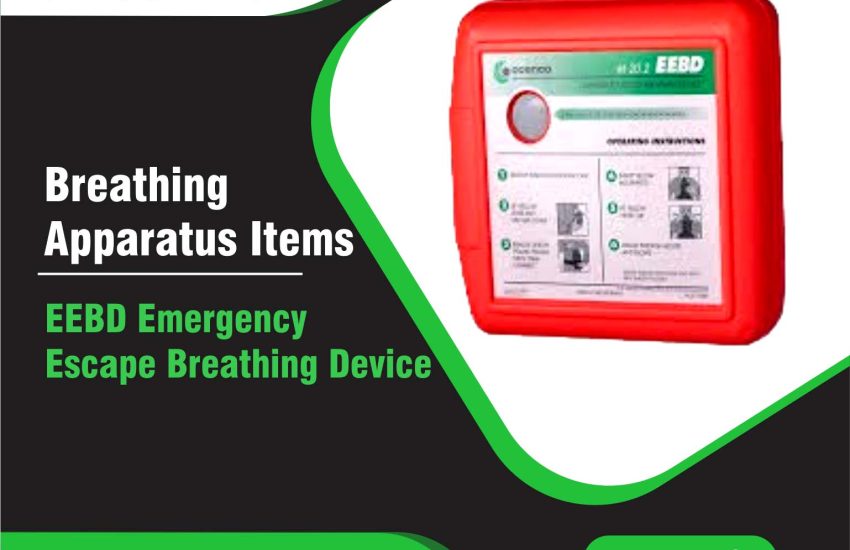An EEBD (Emergency Escape Breathing Device) is a critical safety tool in hazardous environments. It provides breathable air during emergency situations, especially when individuals need to escape from areas with toxic gases or low oxygen levels. Industries like oil and gas, chemical plants, and the marine sector rely heavily on EEBDs to safeguard personnel. This article outlines the EEBD specifications, its key features, and explains why it’s indispensable for emergency escape.
What is an mergency Escape Breathing Device ?
The EEBD Emergency Escape Breathing Device is a portable respiratory protection system. It delivers breathable air in emergencies like fires, toxic gas releases, or oxygen deficiencies. The device helps individuals escape dangerous environments and reach a safe area, especially when normal breathing becomes impossible. EEBDs are essential in high-risk industries where hazardous materials are present, and quick escape is necessary.
EEBD Specifications: Key Features
Understanding the EEBD specifications is crucial when choosing the right safety equipment. Below are the key specifications of a typical EEBD:
Breathing Capacity
An EEBD is equipped with a compressed air cylinder that provides 10 to 15 minutes of breathable air, depending on the model and the user’s air consumption. The typical air volume capacity ranges from 1.5 to 2 liters.
Cylinder Pressure
The air cylinders are pressurized to either 200 bar or 300 bar, depending on the design. This ensures a continuous flow of air during the emergency escape.
Respiratory Protection
The EEBD offers full-face protection and typically includes a demand valve system that delivers air when the user inhales. A safety mask or face shield protects the wearer from smoke, toxic fumes, or chemical splashes.
Lightweight and Portable
Manufacturers design EEBDs to be compact and lightweight, weighing between 1.5 kg and 4 kg. This design ensures that workers can carry them easily and wear them in emergencies without being burdened by heavy equipment.
Ease of Use
EEBDs are user-friendly and designed for activation under stress. Most models feature automatic activation upon removal from their storage container. Users simply don the device and breathe freely.
Storage and Maintenance
To maintain effectiveness, store the EEBD in a cool, dry place, away from direct sunlight or extreme temperatures. Regular inspections are necessary to ensure functionality, including checking the air pressure, cylinder integrity, and the cleanliness of the mask.
Temperature Range
The EEBD operates effectively in temperatures between -20°C and +60°C, making it suitable for extreme environments, whether hot or cold.
Regulatory Compliance
To ensure reliable performance during emergencies, EEBDs must meet international standards such as ISO 23269-1 and EN 13794. These certifications are essential for marine, oil, and gas industries.
Types of EEBDs
There are two main types of EEBDs based on their design and functionality:
Compressed Air EEBD
This type uses a compressed air cylinder to provide breathable air. It is commonly used in industrial and marine environments. Compressed air EEBDs tend to have a higher air capacity and a longer duration than other types.
Self-Contained EEBD
Self-contained EEBDs do not rely on compressed air. Instead, they use a chemical oxygen generation system to supply breathable air. These devices are lighter and more compact but provide a shorter duration of breathable air.
Importance Emergency Escape Breathing Device:
The importance of EEBDs in emergency situations cannot be overstated. These devices are crucial for the following reasons:
Protection Against Toxic Gases
In industrial accidents, toxic gases or fumes can be released, leading to severe health problems. An EEBD helps workers avoid inhaling harmful substances by providing immediate respiratory protection.
Escape from Low Oxygen Environments
In confined spaces or hazardous areas, oxygen levels may drop below safe limits. The EEBD ensures that workers have enough breathable air to reach a safe area.
Fast and Reliable Evacuation
In emergencies, time is of the essence. EEBDs allow for quick escape, reducing the need to wait for rescue teams. This is crucial in hazardous environments.
Compliance with Safety Regulations
In high-risk industries, such as oil, gas, marine, and chemical manufacturing, EEBDs are a regulatory requirement. Their use ensures compliance with health and safety standards, protecting personnel from potential accidents.
Conclusion
Emergency Escape Breathing Device is an essential tool for emergency preparedness. It ensures the safety of workers in environments where hazardous gases or low oxygen levels may exist. With its compact design, lightweight construction, and user-friendly operation, the EEBD provides a reliable and effective way for workers to escape dangerous situations safely.
By understanding its specifications, maintaining the device properly, and ensuring its availability in high-risk industries, businesses can protect their personnel and prevent serious injuries. A properly maintained EEBD as part of an emergency escape plan can save lives and improve safety in critical situations.


